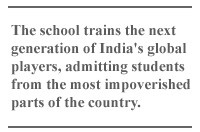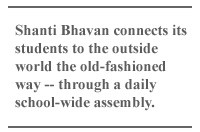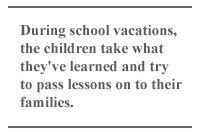Educating for the 21st Century – Part II
Educating for the 21st Century – Part II

DEVEERAPALLI, India – Time travel is possible, and the only machine one needs is a car. The route is the Hosur Road out of Bangalore through the Indian countryside. Beginning with the manicured lawns of Motorola, Siemens, and Wipro, it is possible to glimpse the city’s future. Turning out of this industrial haven, the landscape takes on a new look: the congested brown-colored reality of the present. The buildings shrink and spread out, and the crumbling, tree-lined road eventually gives way to its dirt origins.
Two hours and two centuries down the road, in Deveerapalli, banana fields dominate the horizon, until another oasis of green, manicured lawn appears. This haven is Shanti Bhavan – the abode of peace – technology entrepreneur Abraham George's boarding school for India’s most severely deprived children. The school’s goal is to provide children with the skills necessary to travel to India’s future, up the Hosur Road, to become empowered contributors to modern society.

Dr. Abraham George comes from a line of Indians who left India for more enticing opportunities abroad. His mother moved to Alabama to work for NASA, but he only moved to the United States in the 1980s, when he made his fortunes in the software industry. When he returned to India in 1995, the country had transformed. Companies such as Wipro and Infosys had emerged as world-class enterprises, made by and for Indians to compete worldwide. George thus created Shanti Bhavan to train the next generation of India’s global players, with the additional challenge of only admitting students from the most disconnected and dysfunctional parts of the country.
Shanti Bhavan attempts to eliminate the disparity between the high-skilled workers inside Bangalore’s Electronic City and the slum-dwellers outside its gate by creating world-class educational opportunities for the rural and urban poor. Like so many small ventures in India, the school provides a solid start. But a country of this size will need hundreds of Shanti Bhavans to start narrowing the poverty gap.
In globalization’s initial stages, new overseas markets and competitors had to compete in America's court. In the present stage of globalization, however, more countries are acquiring the resources to compete on their own terms. India is rightly described as one such success story. However, with 600 million village dwellers living in poverty, and most of the new IT wealth concentrated within a tiny segment of the population, it is far too soon to celebrate. The standard of living for those around Bangalore has certainly improved in the last decade, but the per capita income in India remains desperately low, around $500. It is not surprising that most of the population has difficulty accessing the benefits of the technology boom when it still does not have reliable access to running water or electricity.

The premise of Shanti Bhavan is simple: Given a suitable environment and proper resources, even the poorest of the poor can learn to develop into independent, successful adults, equipped to compete for jobs at the highest levels. Shanti Bhavan tests this by first providing a stable academic setting. Students are fed five times a day, bathed, and assigned times for sports and studying. Further, the children are isolated from outside distractions to avoid the countless obstacles – malnourishment, disease, abusive families, superstitions, chores – that would otherwise interfere not only with homework, but with a student’s motivation to learn.

There is no Internet and the phone lines are spotty, but if a visitor asks any student about what's happening in the world, he or she can answer correctly. Without physical or electronic interaction, Shanti Bhavan connects its students to the outside world the old-fashioned way – through a daily school-wide assembly. A teacher presents the world news, headlines from India, and local news. Local news for Bangalore often includes an update on the rising middle-class in Electronics City. In many ways, these children – in the middle of a banana field – are more up to date on world affairs than their American counterparts, who have access to the Internet, newspapers and TVs. The Shanti Bhavan students clearly understand where jobs are located and which industries are growing.
Many students come from households without running water or electricity, but at Shanti Bhavan they are taught to use Microsoft Word and Excel in order to become proficient typists. On the weekends, they watch National Geographic and other educational videos about the outside world. In addition, Shanti Bhavan has had visitors from NASA, professional dance troupes and a nearby medical center whose volunteers provide a much needed health and sex education curriculum.
When the children return home twice a year for three-week vacations, many take what they've learned and try to pass lessons on to their families. In this way, Shanti Bhavan is an example of a little globalization going a long way. It is seldom easy for students to undertake the transition from the modern lifestyle to which they've become accustomed back to abject poverty. Still students do what they can to spread information about proper hygiene and eating habits. Some students even try to teach their parents and siblings English or mathematics.

Shanti Bhavan students all share a common desire to help their families after graduation. Many hope to become doctors or computer engineers. A sixth grade boy, Arun, says: "First and foremost, I'd like to help my family. After I graduate from high school, I'll do part-time jobs and I'll slowly help my family, and when my family is strong enough, I'll use the money to pay for exams and have a strong base for my future."
Abraham George once left India in order to seek opportunities that would allow his family greater comfort in the future, but now the students of Shanti Bhavan need travel no farther than along the ever-shortening Hosur Road to provide for their families. Their career trajectory – like Hosur road – is, however, full of pot holes, and teachers forewarn students to expect difficulties after graduation. Many have already dealt with unsupportive families, sexual abuse, and paralyzing traditional norms. One sixth-grade girl, Chaithra, explains, "Most of the parents in our village, though they know we're educated and though we tell them things are bad, they think it is okay because it's part of their culture."
As the students do their part to improve the lives of the rural poor, they are indirectly helping urban poor by reducing the incentive for villagers to migrate to the city. The small dose of globalization injected by George into the village of Deveerapalli may have tapped a vein that extends through the entire region. The new opportunities of rural education, combined with the opportunities of Bangalore's global connection, will allow more Indians to remain in India – with their own culture, food and way of dressing – while experiencing opportunities that used to only exist overseas. If experiments like Shanti Bhavan are successfully replicated throughout India, as was George's original goal, the backwards sections of the society may one day lead the way into India's future.
Orly Friedman is a junior majoring in Urban Studies at Yale University. She worked as a volunteer teacher at Shanti Bhavan in June 2005.